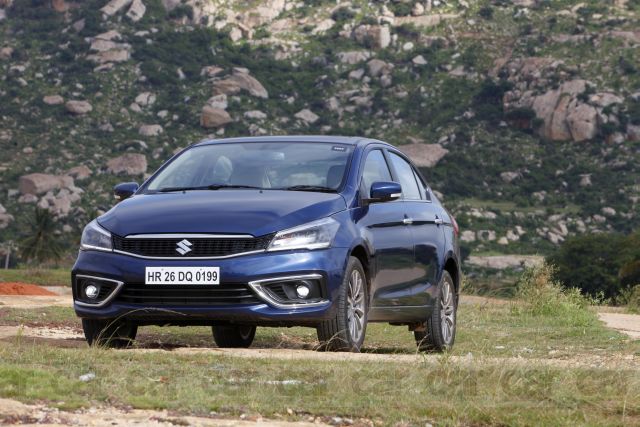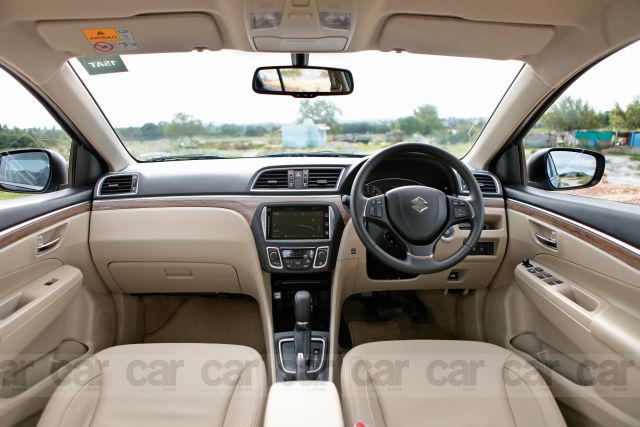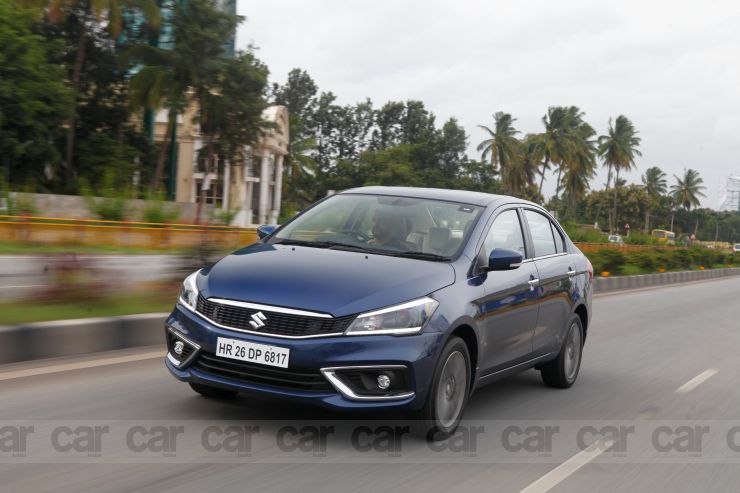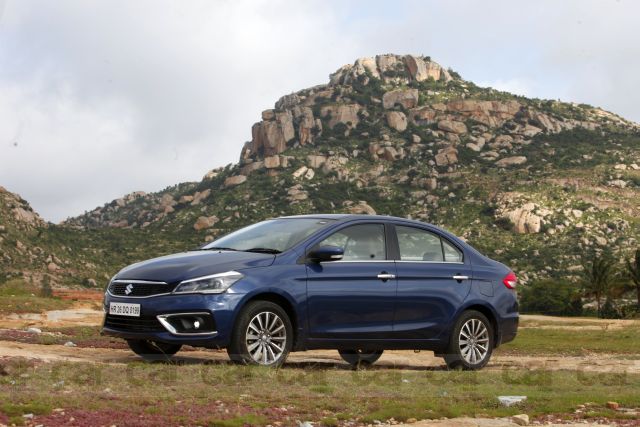The 2018 Maruti Suzuki Ciaz sedan now gets a new 1.5-litre petrol engine equipped with a Smart Hybrid system to compete with arch rivals Honda City and Hyundai Verna, along with newcomer Toyota Yaris. We test drove the 2018 Maruti Suzuki Ciaz in Bangalore to bring you this first drive review.
[metaslider id=19129]
Overview
With the increasing pressure from competition, Maruti had to up their game and have given their sedan a mid-life makeover. It’s the usual facelift recipe — a heap full of new-age features, a dash of styling tweaks, finely finished cabin, and safety features as standard. Although the basic form remains the same, these new tweaks enhance the overall flavour of the car. The new ingredient here is a brand-new K15 1.5-litre petrol engine which replaces the older 1.4-litre unit. The new gasoline engine is more powerful and also comes with an updated smart-hybrid system about which we’ll talk in detail in a while.

Design
The biggest strength of the Ciaz has been its wide and imposing stance, which really adds to the pride of ownership for the consumer. The designers have identified this and enhanced it further by employing a wider front grille which now is extended to the re-profiled headlights. The sleeker bumper makes it look wider and it now comes with three horizontal slats and smart chrome garnish around the LED fog-lamps. The projector headlights feature LED daytime running lights. Moreover, during our drive, which extended beyond sunset, the auto headlamps (with auto levelling) proved to be bright and effective on the narrow city lanes and highways. The front remains as impressive and doesn’t fail to make an impression.
The rear of the car also gets a makeover and is trendy. The split tail-lights are completely LED now and have a great looking lighting profile. There’s a chrome strip on the boot and some more chrome garnish on the rear reflectors, but you’ll be surprised not to find a radio antenna on the roof as it has been incorporated neatly into rear windscreen glass. Lastly, there are the new 16-inch “Precision Cut” alloy wheels and chrome door-handles on higher variants. These essentially complete the major changes that have made the Ciaz more appealing and desirable.
Interiors
I’ve always been impressed by the generous room the Ciaz offers and the new version hasn’t changed for worse either. It is spacious and has become more upmarket and feature-rich now. We were given the top-end Alpha version, so it came with beige leather upholstery, leather-wrapped steering wheel, and chrome garnish on the door-handles and a-c knobs. This goes well with the two-tone dashboard, though the highlight remains the very stylish Birch Blonde wood accents. There are some brush metal bits, too, but the wood with the beige upholstery give it the intended premium car look and feel.
One of the biggest virtues of this sedan is its generous cabin room. The rear seats especially are spacious with ample knee-, head-, and shoulder-room. The rear-seat passengers also get the convenience of a-c vents, window shades, and reading lights. It’s one of the few models in its segment where the buyer doesn’t have to compromise on space or features — a major reason why the Ciaz has sold over 2.2 lakh units since its launch.

Features
Plenty of new features have been added to make the drive more convenient. The seven-inch touchscreen infotainment system remains the same and continues to support smartphones through Android Auto, Apple CarPlay, and MirrorLink. The new bit includes an updated voice command system which can be used to dictate and send WhatsApp messages while driving. Safety features such as ABS with EBD, dual front airbags, and seat-belt reminder for front passengers are standard. On the go, I enjoyed using the new 4.2-inch colour TFT information display which gives the driver vital information about the car and even changes the illumination colour depending on how hard you are on the accelerator pedal. Confession: I saw a lot of red. Apart from the regular info such as fuel consumption, trip meter, gear indicator, and driving range, it also displays the flow of energy from and to the new hybrid system. (Also read: Maruti Suzuki Ciaz variants and price)
Engine
Speaking of which, both the petrol and diesel versions come with the smart hybrid system. Since the DDiS 200 1.3-litre oil-burner remains unchanged, we were obviously more curious to explore the new K15 1.5-litre petrol. So, we drove the new for India engine in both its five-speed manual and four-speed torque converter AT avatars. Compared to the outgoing 1.4-litre petrol, the new engine is not just larger in size but also more powerful and, with the hybrid system, promises to be frugal as well. The new system is smarter and more advanced than the older generation micro-hybrids seen on some other Maruti cars. Earlier there was a lead-acid battery which essentially worked as a start-stop system every time the car was brought to a standstill. But the new set-up comes with two batteries: a lead-acid along with a new lithium-ion. The conventional lead-acid takes care of the start-stop function as before, while the new lithium-ion chips into the engine performance during acceleration by providing additional torque to the 138 Nm of the combustion engine.
The TFT displays the power flow — from the hybrid system to the front wheels while acceleration and, as I let go of the gas or when I hit the brake, the energy is utilized to charge the batteries. The boost from the battery isn’t shattering but it does reduce the stress on the engine and helps improve fuel efficiency to a certain extent. The overall performance of the 105-PS, K15 petrol is a step up from before and seems adequate for a sedan of this size. Thus, it’s not the sportiest in the segment but peppier than before.
Performance
The four-speed automatic isn’t the slickest in the business. With pedal to the metal, the Ciaz AT feels a tad lazy, especially when you expect it to kick down. And there aren’t any paddle-shifters either, so you’re at the mercy of the torque converter. The automatic has been ideally tuned for city commutes and does a fine job of transporting you around leisurely and, with a claimed fuel efficiency of 20.28 km/l, is economical for daily use as well. Besides, it gets a few pre-set gear ratios, including a “Low” for driving on steep inclines and a hill-hold feature which automatically stops the car from rolling back on slopes.
Cruising at 80 km/h, I was in for a revelation: the government’s newly implemented road safety regulation. The TFT unit lets out a beep every minute to inform the driver about the speed. Cross 120 km/h and it begins to beep non-stop. Yes, non-stop! It’s extremely annoying and, therefore, pretty effective. Most drivers in a hurry will end up with a headache due to the constant beeping or will set the cruise control just below the mark.
Now for a quick pit-stop and a cup of strong coffee before we drive ahead in the manual variant. Like most manual cars, it’s fun to play with the five-speed version. Since you dictate the gear-shifts, it feels quicker to hit the 100 km/h mark. We’ll confirm this when we get to do a full-fledged road test of the new car. However, we’re happy to report that the K15 didn’t lose steam even when we pushed it beyond 150 km/h on the clock. The engine NVH and refinement are impressive at low speeds, though belting it on the highway it tends to sound a tad coarse.

Handling and Ride Quality
At low speed, the steering feels heavier than most other Maruti cars and it required a little extra effort during lock-to-lock parking manoeuvres but as you gain speed, the steering feel improves. The company engineers confirmed my hunch about the revised suspension set-up: the 2018 version feels more pliant and comfortable than before. There was no shortage of bad roads and the Ciaz took most of those in its stride. The tweaking has been to improve passenger comfort and it shows. A minor issue, however, is the relatively low ground clearance that scrapes over larger speed-breakers.
Price
To conclude, the Ciaz has been one of the drivers for the success of the premium Nexa dealerships. The extremely aggressive pricing, beginning from Rs 8.19 lakh, will ensure a higher footfall. The top-end Alpha manual we drove costs Rs 9.97 lakh while the Alpha automatic is priced at Rs 10.97 lakh (all ex-showroom). With these tempting prices and the option of diesel, petrol, manual, and automatic to choose from, it won’t be easy for the reigning champions to dodge the punches as the 2018 Ciaz facelift surges ahead to conquer the segment yet again.





















Leave a Reply